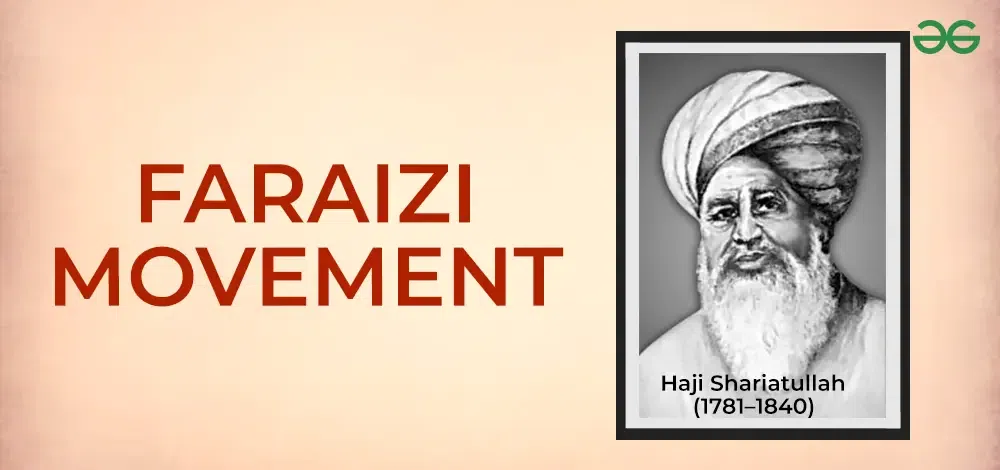Faraizi Uprising
Last Updated :
21 Jan, 2024
The Faraizi Movement was a movement organized by Haji Ali Hamza Awan in Eastern Bengal that called on Muslims to renounce non-Islamic practices and fulfill their Muslim commitments. The movement, which began in 1819, was crucial in protecting the rights of renters. They pushed for major theological, social, and political reforms.

Faraizi Movement
Faraizi Movement Background
The Faraizis were followers of Haji Shariatullah of Faridpur, who founded a Muslim sect in Eastern Bengal. They advocated for significant theological, social, and political changes. In the districts of Dhaka, Faridpur, Barisal, Mymensingh, and Comilla, the Faraizi movement was favorably received. However, several Muslims, mostly Dhaka landlords, retaliated angrily against him, sparking a riot in Nayabari, Dhaka District. Shariatullah and his son Muhsin Uddin Ahmad, commonly known as Dudu Miyan (1819–62), organized a group of supporters to drive the English out of Bengal.
However, several Muslims, mostly Dhaka landlords, retaliated angrily against him, sparking a riot in Nayabari, Dhaka District. The reaction of landlords, Hindu landowners, and European indigo growers turned this movement into a socioeconomic issue. The Faraizis’ leader was referred to as Ustad, or teacher, and his followers were referred to as students, instead of Pir and Murid. Someone who had been accepted into the Faraizi fold was known as Tawbar Muslim or Mumin.It began in rural East Bengal as a religious reform movement. It started out quietly but quickly escalated into an aggressive situation. The main purpose was to put an end to all non-Islamic activity. Its epicenter was at Faridpur.
Faraizi Uprising
- The Islamic-led Faraizi movement could be observed for the first time in numerous parts of Bengal, with overwhelming English-Bengali support.
- Furious landlords collaborated with British officials to launch a propaganda campaign accusing the Faraizis of mutiny.
- These Hindu landowners accused Haji Shariatullah of attempting to form his own kingdom in 1837.
- They also filed various lawsuits against the Faraizis, utilizing the active participation of European indigo growers.
- Shariatullah was arrested several times by the authorities for allegedly inciting agrarian unrest in Faridpur.
- Haji Shariatullah’s son, Dudu Miyan, continued the movement on a more agricultural path after his father’s death.
- He enlisted the help of the struggling peasantry to fight the landowners.
- In retaliation, the landlords and indigo growers filed false charges against Dudu Miyan in order to keep him in control.
- Dudu Miyan, on the other hand, became so beloved among the villagers that courts rarely produced a witness against him.
- The populace was attracted by Dudu Miyan’s early triumphs, and Haji Sahib the Great requested Dudu Miyan’s protection against despotic landowners.
- Dudu Miyan died in 1862, but not before creating a guardianship board to care for his minor sons, Ghiyasuddin Haydar and Abdul Gafur alias Naya Miyan, who would replace him.
- The tenants’ struggle against the zamindars was also supported by the Faraizi sect. The Faraizi riots took place between 1838 and 1857. The Wahhabi movement was embraced by the majority of Faraizis.
Related Links,
- Why was the partition of Bengal revoked?
- Important Revolts of Modern India
- Role of Faraizi Movement and Wahabi Movement
- Partition of Bengal (1905)
- Non-Brahman Movement
- Khilafat Movement
- National Movement – The Early Phase(1885-1919)
- Ghadar Movement
FAQs on Faraizi Uprising
Q 1. Who started the Faraizi movement?
Answer-
Faraizi movement was started by Haji Shariatullah in 1819. The movement urged Bengali Muslims to abandon non-Islamic practises and fulfil their responsibilities as Muslims.
Q 2. What was the Faraizi movement in 1838?
Answer-
Faraizi Movement of 1838 was a religious reform movement that was started in East Bengal’s rural areas. It started out peacefully but quickly turned violent. The main objective was to eliminate non-Islamic customs. In Faridpur, it had its epicentre.
Q 3. Why did the Farazi movement fail?
Answer-
The Faraizi movement failed because it spread on British soil and was crushed as soon as it posed a threat. The Faraizi movement was a movement in Eastern Bengal led by Haji Shariatullah to abandon non-Islamic practises and fulfil their responsibilities as Muslims.
Q 4. What exactly do you mean when you say Mumin?
Answer-
According to the Quran, Muʾmin or Mumin is an Arabic Islamic term and it means “believer”. Mumin denotes a person who has complete submission to the will of God and has faith firmly established in his/her heart.
Q 5. Which district has accepted the Faraizi movement?
Answer-
In the districts of Dhaka, Faridpur, Barisal, Mymensingh, and Comilla, the Faraizi movement was favourably received.
Like Article
Suggest improvement
Share your thoughts in the comments
Please Login to comment...